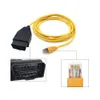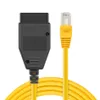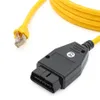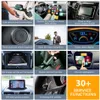The ENET cable is a valuable tool for diagnosing issues in BMW F-Series vehicles. Its durability, compatibility with different models, ease of use and affordability make it a popular choice among car owners. Compared to other diagnostic tools like OBD-II scanners or handheld devices, the ENET cable offers greater accuracy, faster results, and more comprehensive diagnostic capabilities. This article provides step-by-step instructions for using the ENET cable and includes screenshots and diagrams to illustrate the process. The guide highlights tips and tricks that even non-technical readers can understand. Whether you are a DIY mechanic or a professional technician, the ENET cable is a great investment for anyone looking to diagnose and fix issues in their BMW.








Features and Benefits
Durability:
One of the most significant features of the ENET cable is its durability. Unlike other cables, ENET cables are made from high-quality materials that can withstand daily use and abuse. The cable’s robust design ensures long-lasting performance, protecting it from wear and tear over time. This feature is particularly important for BMW F-Series owners who rely on their cars for daily commutes or professional purposes.
Compatibility:
Another critical feature of the ENET cable is its compatibility with various models of BMW F-Series vehicles. This compatibility ensures that any BMW owner with an F-Series model can use the cable to diagnose their car’s issues. Additionally, this compatibility makes the cable an excellent investment for professional mechanics who work on multiple BMW models. With the ENET cable, professionals can diagnose and fix problems across different BMW models without having to purchase multiple cables.
Ease of Use:
The ENET cable is incredibly user-friendly, making it easy for BMW owners and mechanics to diagnose and repair their vehicles. The cable comes with detailed instructions for installation and use, ensuring that even those with minimal technical experience can use it efficiently. Moreover, the cable’s plug-and-play design means that no additional software or tools are required, saving users time and money.
Affordability:
Despite its high-quality features and versatility, the ENET cable remains affordable for all BMW enthusiasts. Compared to other diagnostic tools in the market, the ENET cable is relatively inexpensive, making it accessible to a broader range of users. This affordability ensures that BMW owners can diagnose and fix their vehicle’s problems quickly and cost-effectively.
Benefits:
Each of the ENET cable’s features has direct benefits for BMW F-Series owners. The cable’s durability ensures that it does not break down easily, keeping it functional for extended periods. Its compatibility means that it can be used across multiple BMW models, making it an excellent investment for professionals who work on these vehicles. Additionally, the cable’s ease of use allows users to diagnose and fix problems without having to seek professional help, saving them time and money. Finally, the cable’s affordability makes it accessible to a broader range of BMW owners, allowing them to take charge of their vehicle’s maintenance costs.
Comparison with Other Diagnostic Tools
Firstly, let’s start with the basics. The ENET cable is a specialized cable that connects your car’s OBD port to a computer or mobile device. Once connected, it provides access to your vehicle’s onboard computer system, allowing you to perform advanced diagnostic tests and programming tasks.
One of the primary advantages of using the ENET cable over other diagnostic tools is its greater accuracy. Unlike OBD-II scanners, which only provide basic diagnostic information, the ENET cable can access more detailed data from your vehicle’s onboard computer system. This enables you to identify even the most minor issues that may be affecting your vehicle’s performance, which can be crucial in preventing them from escalating into more severe problems.
Another advantage of using the ENET cable is that it provides faster results. Handheld diagnostic devices often require you to manually input information about your vehicle, such as the make and model, before they can begin the diagnostic process. This can be time-consuming and lead to delays in identifying issues. In contrast, the ENET cable automatically retrieves all relevant information from your car’s onboard computer system, allowing you to quickly and easily diagnose any problems.
Additionally, the ENET cable offers more comprehensive diagnostic capabilities than other alternatives. With its ability to access more detailed data from your vehicle’s onboard computer system, it enables you to conduct more advanced diagnostic tests and programming tasks. This can include everything from checking for fault codes and resetting warning lights to programming new features into your vehicle’s electronics.
Furthermore, the ENET cable is incredibly versatile, making it an excellent choice for both professional mechanics and home DIY enthusiasts. Its compatibility with a variety of software applications means that you can choose the best tool for your specific needs, whether that be diagnosing complex issues or performing simple programming tasks.
How to Use the ENET Cable
Step 1: Purchase the ENET cable
To begin, you’ll need to purchase an ENET cable. There are numerous options available online, but it’s important to choose a reputable seller. Once you’ve received your cable, be sure to inspect it for any damage before using it.
Step 2: Install the necessary software
Before using the ENET cable, you’ll need to install the software needed to interface with your BMW vehicle. There are a variety of software options available, including BMW ISTA, INPA, and Rheingold. Depending on your level of technical expertise, certain software may be easier to use than others. Regardless of which software you choose, be sure to follow the installation instructions carefully.
Step 3: Connect the ENET cable
Once you’ve installed the necessary software, you’re ready to connect the ENET cable to your BMW vehicle. Locate the OBD-II port in your car; it’s usually found under the dashboard near the driver’s side. Plug one end of the ENET cable into the OBD-II port and the other end into your laptop.
Step 4: Run the software
With the ENET cable connected, open the software and select your BMW model. The software will automatically scan your vehicle’s systems and communicate with them through the ENET cable. This process may take several minutes, so be patient.
Step 5: Diagnose common issues
Once the software has established a connection with your vehicle, you can begin diagnosing common issues. For example, if you’re experiencing engine problems, you can use the ENET cable to read fault codes and identify the source of the issue. Similarly, if your transmission is acting up, the ENET cable can be used to monitor transmission fluid levels and adjust shifting patterns.
Tips and Tricks
While using the ENET cable may seem daunting at first, there are several tips and tricks that can make the process much easier. For example, be sure to keep your laptop fully charged or plugged in during the diagnostic process. Additionally, take note of any error codes or system malfunctions that occur during the diagnosis. These notes can be helpful when discussing the issue with a mechanic or dealership.
Conclusion
Using the ENET cable to diagnose common issues in your BMW F-Series vehicle is a crucial task for any owner. By following these simple steps and utilizing the software properly, you can save time and money by identifying and addressing issues early on. With clear, easy-to-follow instructions and helpful tips, even non-technical readers can get the most out of their ENET cable.
FAQ
Q1. What is an ENET cable and how does it work with BMW F-Series vehicles?
The ENET cable is a diagnostic tool specifically designed for use with BMW F-Series vehicles. It allows for direct communication with the vehicle’s onboard computer system, enabling users to perform diagnostics, coding, and programming tasks. The cable plugs into the vehicle’s OBD-II port and connects to a compatible computer or diagnostic tool, providing access to the vehicle’s various systems.
Q2. Is the ENET cable durable and compatible with BMW F-Series vehicles?
Yes, the ENET cable is constructed with high-quality materials and designed to withstand the rigors of professional use in automotive diagnostics. It is also fully compatible with BMW F-Series vehicles, ensuring reliable and seamless communication with the vehicle’s onboard systems.
Q3. Can I use the ENET cable for both diagnostic and coding tasks on my BMW F-Series vehicle?
Yes, the ENET cable is versatile and can be used for a wide range of tasks, including diagnostics, coding, and programming. This makes it an essential tool for both professional technicians and DIY enthusiasts working on BMW F-Series vehicles.
Q4. Are there any special requirements for using the ENET cable with BMW F-Series vehicles?
In order to use the ENET cable with BMW F-Series vehicles, it is important to ensure that the accompanying software or diagnostic tool is compatible with the vehicle’s systems. Additionally, some tasks may require specific knowledge or training in BMW diagnostics and coding procedures. It is recommended to consult the vehicle’s service manual or seek professional assistance when performing advanced tasks with the ENET cable.